2.5C: Fimbriae and Pili
- Page ID
- 3148
- State the chemical composition, structure, and function of the short adhesion pili of bacteria.
- State the function of a bacterial conjugation (sex) pilus.
- Define bacterial conjugation.
- State how the ability to change the shape of the adhesive tip of its pili could be an advantage to a bacterium.
- Briefly describe twitching motility induced by type IV pili.
Highlighted Bacterium
- Read the description of Neisseria gonorrhoeae and match the bacterium with the description of the organism and the infection it causes.
Structure and Composition
Fimbriae and pili are thin, protein tubes originating from the cytoplasmic membrane of many bacteria. Both are able to stick bacteria to surfaces, but pili are typically longer and fewer in number than fimbriae. They are found in virtually all Gram-negative bacteria but not in many Gram-positive bacteria. The fimbriae and pili have a shaft composed of a protein called pilin. At the end of the shaft is the adhesive tip structure having a shape corresponding to that of specific glycoprotein or glycolipid receptors on a host cell (Figure \(\PageIndex{1}\)). There are two basic types of pili: short attachment pili and long conjugation pili.

Short attachment pili, also known as fimbriae, are usually short and quite numerous (Figure \(\PageIndex{1}\)) and enable bacteria to colonize environmental surfaces or cells and resist flushing.

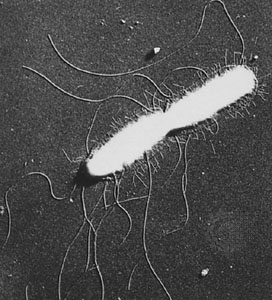
Long conjugation pili, also called "F" or sex pili (Figure \(\PageIndex{4}\)), that are longer and very few in number. The conjugation pilus enables conjugation. As will be seen later in this unit, conjugation is the transfer of DNA from one bacterium to another by cell-to-cell contact. In gram-negative bacteria it is typically the transfer of DNA from a donor or "male bacterium" with a sex pilus to a recipient or "female bacterium" to enable genetic recombination.

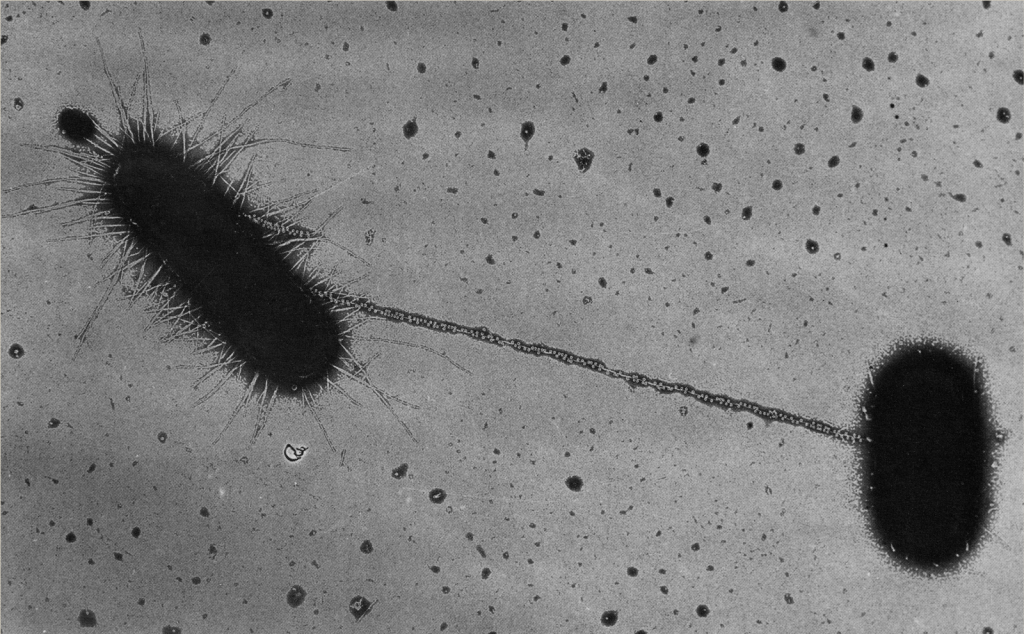
Significance of Pili to Bacterial Pathogenicity
The short attachment pili or fimbriae are organelles of adhesion allowing bacteria to colonize environmental surfaces or cells and resist flushing. The pilus has a shaft composed of a protein called pilin. At the end of the shaft is the adhesive tip structure having a shape corresponding to that of specific glycoprotein or glycolipid receptors on a host cell (Figure \(\PageIndex{1}\)). Because both the bacteria and the host cells have a negative charge, pili may enable the bacteria to bind to host cells without initially having to get close enough to be pushed away by electrostatic repulsion. Once attached to the host cell, the pili can depolymerize and enable adhesions in the bacterial cell wall to make more intimate contact.
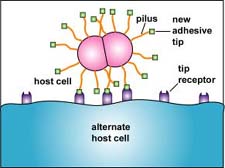
|
Highlighted Bacterium: Neisseria gonorrhoeae Click on this link, read the description of Neisseria gonorrhoeae, and be able to match the bacterium with its description on an exam. |
One class of pili, known as type IV pili , not only allow for attachment but also enable a twitching motility. They are located at the poles of bacilli and allow for a gliding motility along a solid surface such as a host cell. Extension and retraction of these pili allows the bacterium to drag itself along the solid surface (see Figure \(\PageIndex{5}\)). In addition, bacteria can use their type IV pili to "slingshot" the bacterium over a cellular surface. In this case, as the pili contract they are thought to become taut like a stretched rubber band. When an anchoring pilus detaches, the taut pili "slingshot" the bacterium in the opposite direction (see Figure \(\PageIndex{6}\)). This motion typically alternates with the twitching motility and enables a more rapid motion and direction change than with the twitching motility because the rapid slingshotting motion reduces the viscosity of the surrounding biofilm.
This enables bacteria with these types of pili within a biofilm to move around a cellular surface and find an optimum area on that cell for attachment and growth once they have initially bound. Bacteria with type IV pili include Pseudomonas aeruginosa, Neisseria gonorrhoeae, Neisseria meningitidis, and Vibrio cholerae.
- Electron micrograph of type IV pili of Neisseria gonorrhoeae from Magdalene So, University of Arizona
|
You Tube movie showing twitching motility in Pseudomonas due to type IV pili
Courtesy of Dr. Lori Burrows You Tube videos |
|
You Tube movie showing Pseudomonas using type IV pili to "walk" on end following binary fission.
Courtesy of Gerard Wong, UCLA Bioengineering, CNSI |
|
Movie of twitching motility of Pseudomonas
Courtesy of Dr. Howard C. Berg from the Roland Institute at Harvard. |
|
Retraction of pili of Pseudomonas used in twitching motility
Courtesy of Dr. Howard C. Berg from the Roland Institute at Harvard. |
Neisseria gonorrhoeae is a gram-negative diplococcus that has multiple alleles coding for different and distinct pili adhesive tips as well as different and distinct cell wall adhesins called Opa proteins.
The gonococcus is able to colonize and infect a numerous sites in the body, including the urethra, the rectum, the throat, the conjunctiva of the eye, and the fallopian tubes. It can also colonize sperm.
- Considering the locations in the body where it colonizes, why doesn't the body simply flush the bacterium out of the body?
- Why is N. gonorrhoeae able to colonize so many different sites in the body?
- We recognize pili adhesive tips and cell wall adhesins as foreign and, during adaptive immunity, make antibodies that bind to these microbial molecules. State how this might help to protect the body.
Significance of Fimbriae and Pili in the Initiation of Body Defense
Initiation of Adaptive Immunity
Proteins associated with bacterial fimbriae and pili function as antigens and initiate adaptive immunity. An antigen is defined as a molecular shape that reacts with antibody molecules and with antigen receptors on lymphocytes. We recognize those molecular shapes as foreign or different from our body's molecular shapes because they fit specific antigen receptors on our B-lymphocytes and T-lymphocytes, the cells that carry out adaptive immunity.
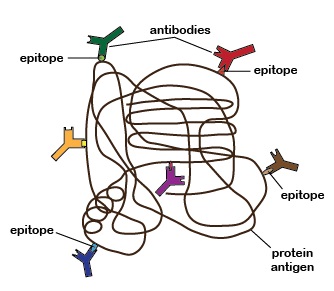
Epitopes of an Antigen (Polysaccharide). Proteins have many epitopes of different specificities. During humoral immunity, antibodies are made to fit each epitope of each antigen.
The actual portions or fragments of an antigen that react with antibodies and with receptors on B-lymphocytes and T-lymphocytes are called epitopes . An epitope is typically a group of 5-15 amino acids with a unique shape that makes up a portion of a protein antigen, or 3-4 sugar residues branching off of a polysaccharide antigen. A single microorganism has many hundreds of different shaped epitopes that our lymphocytes can recognize as foreign and mount an adaptive immune response against.
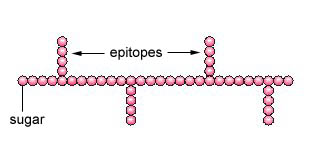
Epitopes of an Antigen (Polysaccharide)
The body recognizes an antigen as foreign when epitopes of that antigen bind to B-lymphocytes and T-lymphocytes by means of epitope-specific receptor molecules having a shape complementary to that of the epitope. The epitope receptor on the surface of a B-lymphocyte is called a B-cell receptor and is actually an antibody molecule. The receptor on a T-lymphocyte is called a T-cell receptor (TCR).
There are two major branches of the adaptive immune responses: humoral immunity and cell-mediated immunity.
1. Humoral immunity: Humoral immunity involves the production of antibody molecules in response to an antigen and is mediated by B-lymphocytes. Through a variety of mechanisms, these antibodies are able to remove or neutralize microorganisms and their toxins after binding to their epitopes. For example, antibodies made against pili antigens can stick bacteria to phagocytes, a process called opsonization. Antibodies made against the adhesive tips of pili can prevent bacteria from adhering to and colonizing host cells.
2. Cell-mediated immunity: Cell-mediated immunity involves the production of cytotoxic T-lymphocytes, activated macrophages, activated NK cells, and cytokines in response to an antigen and is mediated by T-lymphocytes. These defense cells help to remove infected cells and cancer cells displaying foreign epitopes.
Adaptive immunity will be discussed in greater detail in Unit 6.
|
Medscape article on infections associated with organisms mentioned in this Learning Object. Registration to access this website is free.
|
Summary
- Fimbriae and pili are thin, protein tubes originating from the cytoplasmic membrane found in virtually all Gram-negative bacteria but not in many Gram-positive bacteria. Pili are typically longer and fewer in number than fimbriae.
- The short attachment pili or fimbriae are organelles of adhesion allowing bacteria to colonize environmental surfaces or cells and resist flushing.
- The long conjugation pilus enables conjugation in Gram-negative bacteria.
- The pilus has a shaft composed of a protein called pilin with an adhesive tip structure at the end having a shape corresponding to that of specific receptors on a host cell.
- The same bacterium may switch the adhesive tips of the pili in order to adhere to different types of cells and evade immune defenses.
- Type IV pili not only allow for attachment but also enable a twitching motility that enables bacteria to “crawl” or “walk” over the surfaces to which they have attached by extending and retracting their type IV pili.
Questions
Study the material in this section and then write out the answers to these questions. Do not just click on the answers and write them out. This will not test your understanding of this tutorial.
- State the function of the short adhesion pili of bacteria. (ans)
- Define bacterial conjugation. (ans)
- State how the ability to change the shape of the adhesive tip of its pili could be an advantage to a bacterium. (ans)
- Multiple Choice (ans)


